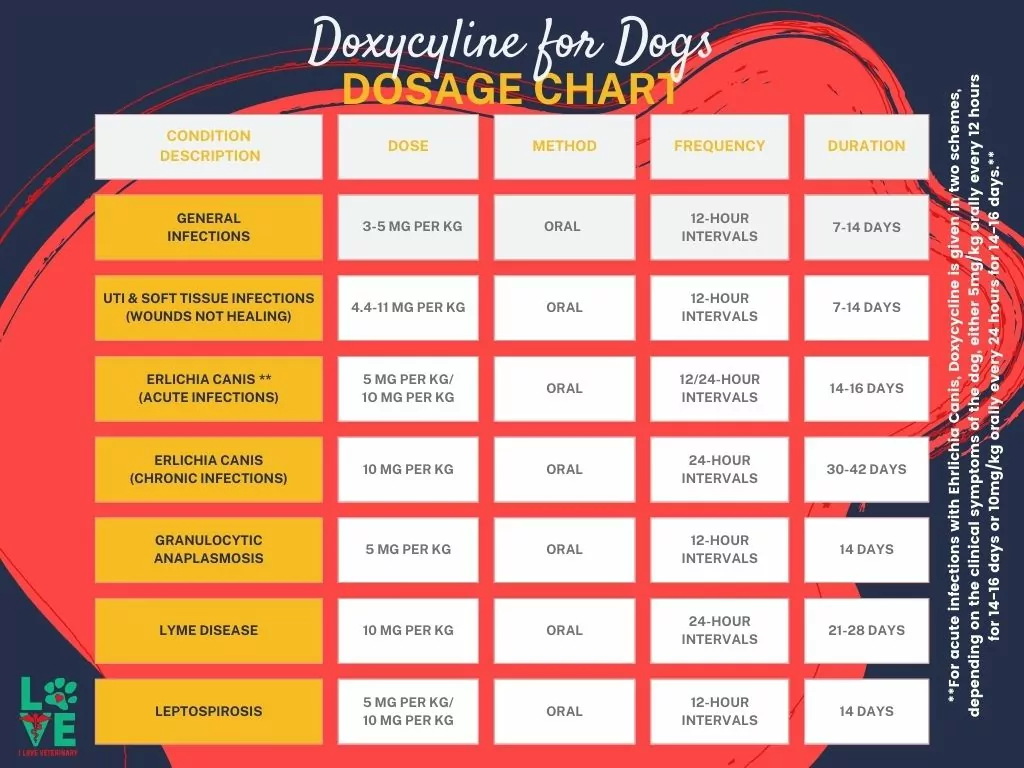Can Dogs Take Doxycyline?
Doxycycline is an antibiotic from the tetracycline group commonly used in veterinary medicine to treat a variety of conditions and diseases in dogs and cats. Tetracyclines are a group of broad-spectrum antibiotics, and they all have a similar basic compound.
Tetracyclines are either isolated from Streptomyces bacteria directly or semi-synthetically from the isolated compounds. This group of antibiotics was discovered in the 1940s.
At the moment, on the market, there are no veterinary-approved products, but veterinarians are prescribing 100mg capsules, 50mg tablets, or 25mg oral suspension of doxycycline for dogs.
What is Doxycyline for dogs? In domestic animals, doxycycline for dogs is used to treat microorganisms such as Borrelia, Leptospira, Rickettsiae, Chlamydia, Mycoplasma, Bartonella, and Bordetella.
All tetracyclines act as a bacteriostatic by inhibiting the protein synthesis of the ribosomes, and by altering the permeability of the cytoplasmatic membrane of the susceptible organisms.
What Is Doxycyline Used for In Dogs?
As an animal antibiotic with a broad spectrum, Doxycycline for dogs is used to treat several different conditions. The most common conditions in which the veterinarian might prescribe doxycycline are:
- Ehrlichiosis (a tick-borne disease)
- Rocky Mountain spotted fever (a tick-borne disease)
- Anaplasma in dogs (a tick-borne disease)
- Lyme disease (a bacterial disease)
- Canine Leptospirosis (a bacterial disease)
- Heartworms in dogs (a parasitic disease)
- Toxoplasmosis (a parasitic disease)
- Mycoplasma
- Chlamydia
- Severe respiratory infections
- Severe urinary tract infections (recurrent or non-responsive to other antibiotics)
- Infected dog wounds
It is very important not to use this broad-spectrum antibiotic lightly and without a veterinarian prescription and guidance. This is a very potent antibiotic, and if used in a situation when it is not needed can lead to resistance of the dog to the drug and, if potentially needed, one day for one of the diseases mentioned above not effective.

Doxycyline Side Effects In Dogs
In a case study conducted by B. S. Schulz (Dr. Med. Vet), and associates, they reported that 18% of the dogs that were given Doxycycline were experiencing nausea and vomiting, 7% of the dogs in the study had dog diarrhea and 2.5% of them developed anorexia.
Almost 40% of the tested canine patients showed increased activity of the liver transferases ALT and AST, and 36% of the dogs showed increased activity of the alkaline phosphatase.
These findings show that this antibiotic is very potent and heavy for the liver, the organ through which this drug is excreted from the body (Schulz et al., 2011).
Because of cases like these, it is suggested that all dogs that are taking doxycycline for any of the diseases mentioned above to be given some type of canine liver supplement in the form of pills or oral suspension.
- Liver Support for Dogs: Denamarin is the #1 veterinarian recommended liver support supplement for dogs. This supplement contains s-adenosylmethionine (SAMe) to help increase levels of the antioxidant glutathione – one of the liver’s main detoxifying agents
- High-Quality Ingredients: The Silybin found in Denamarin has shown better absorption by dogs than the standardized milk thistle extract found in many other products
- Support Your Dog’s Liver Health: The liver, one of your pet’s most vital organs, is responsible for removing toxins, storing energy, aiding digestion, and supporting the immune system
- Used by veterinarians to support Liver health in dogs that have elevated Liver enzymes.
- Supports phase 1 and phase 2 liver detoxification pathways.
- 15 unique ingredients to support Liver health and Normal detoxification function.
- America’s #1 Selling Dog Supplement Brand on Amazon*
- Healthy Liver = Happy Life! – Zesty Paws Liver Support Bites are chewable supplements with ingredients that support canine liver health.
- Featuring Silactive – At 110 mg per chew, Silactive is a standardized form of Milk Thistle, an herbal extract with properties that support the liver’s normal detoxifying process.
- Liver Support for Dogs & Cats: Denamarin is the #1 veterinarian recommended liver support supplement for dogs and cats. This supplement contains s-adenosylmethionine (SAMe) to help increase levels of the antioxidant glutathione – one of the liver’s main detoxifying agents
- High-Quality Ingredients: The Silybin found in Denamarin has shown better absorption by dogs and cats than the standardized milk thistle extract found in many other products
- Support Your Dog and Cat’s Liver Health: The liver is one of the most vital organs in your pet and is responsible for removing toxins, storing energy, aiding digestion, and supporting the immune system
- Organic Milk Thistle for Dogs – Coco and Luna Liver and Kidney Support contains Milk Thistle which is a safe and powerful ingredient that provides liver support for dogs by eliminating toxins and working as a natural dog detox.
- Liver Support – Our liver supplements for dogs are a strong cleanser of impurities found in the liver, promotes liver health and also assists with overall kidney support.
- Dog Kidney Support – Our formula harnesses the benefits of Choline, L-Arginine, Dandelion Root, and Yellow Dock to promote holistic kidney well-being in dogs, aiding in toxin elimination, optimal function, enhancing blood flow to the kidneys, and overall vitality.
Doxycycline should not be given to pregnant dogs. During the dog gestation period, there’s the risk of bone abnormalities and dog teeth discoloration in the developing fetuses.
The elimination of Doxycycline from the dog’s body is unique. The drug is primarily excreted through the feces via non-biliary routes. It is excreted in an inactive form. It is believed that the drug is partially inactivated in the intestine by the chelate formation and only after inactivation is excreted into the intestinal lumen.
In dogs, about 75% of a given dose is excreted in this manner. Renal excretion of Doxycycline is only 25% of a dose in dogs, and biliary excretion less than 5%.
Long-term therapy with tetracyclines can lead to overgrowth of bacteria non-susceptible to this antibiotic, and fungi.

Doxycycline Drug Interactions
Giving a dog Doxycyline implies this medication has interaction with almost everything else that might be given as a medication. Always remember to ask your veterinarian if any of your dog’s supplements is taking might interact with Doxycycline.
In general, any oral antacids or oral iron will interact with the absorption of Doxycycline. Because of that, make sure that you give this antibiotic and other dog supplements two to three hours apart.
Doxycycline should not be given in combination with any antibiotic from the following groups: penicillin, aminoglycosides, and cephalosporins. When Doxycycline is given in combination with an antibiotic from these groups, it will reduce the effectiveness of the second antibiotic and overwhelm the liver and the kidneys.
If a dog suffers from epilepsy and is taking phenobarbital, prescribing Doxycycline in combination with phenobarbital might affect the way the pet will metabolize the antibiotic.
Patients on blood thinners, such as Warfarin, if given Doxycycline, must be monitored closely. The antibiotic might interact with the clotting ability.
The Proper Doxycyline Dose for Dogs
Dosing of doxycycline for dogs is different depending on the infection.

These diseases are the main reasons veterinarians prescribe doxycycline for dogs. Be aware that this is a potent and heavy drug, and you must comply with all directions on how to give the antibiotic provided by your veterinarian.
How is Doxycycline Given to Dogs?
Doxycycline for dogs is available on the market in the form of a capsule, tablet, and oral suspension. It is advised to give doxycycline with food to avoid stomach upset, diarrhea, and vomiting. Never give another dose of doxycycline if your dog vomits in the next hour after getting the antibiotic.
The capsule and the tablet can be mixed with food. Never open the capsule to pour the powder onto the food. Removing the capsule will make the drug ineffective. If your dog does not want to eat the capsule or the tablet with the food, put it in a little piece of butter and put it directly in the throat behind the tongue.
This way, the dog won’t be able to spit the antibiotic, and the butter will help ease the way down the throat to the stomach.
If you are looking for Doxycyline for your dog, we can recommend the following trusted supplier: Vet Approved RX Doxycycline Oral Suspension.
Summary
Doxycycline for dogs is a powerful antibiotic from the tetracycline group. It is used in veterinary medicine to treat a variety of infections in dogs and cats. The most common reasons your dog might get a prescription of doxycycline are E.canis infection, Lyme disease, Leptospirosis, Anaplasmosis, various respiratory infections resistant to other antibiotics.
Always follow the guidelines prescribed by your veterinarian, and never give doxycycline to your pet without a veterinary consult.
Reference List
Schulz, B. S., Hupfauer, S., Ammer, H., Sauter-Louis, C., & Hartmann, K. (2011). Suspected side effects of Doxycycline use in dogs – A retrospective study of 386 cases. Veterinary Record, 169(9), 229–229. https://doi.org/10.1136/vr.d4344





